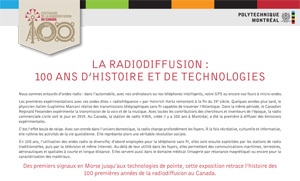As soon as there was word that we could organize an event to mark the centennial of Canadian broadcasting, some members of the SQCRA came forward to collaborate. In December 2018, an informal meeting took place between Serge Tatu, professor of electrical engineering at INRS, David Dousset, coordinator of a research group at Polytechnique Montreal, and Alain Dufour. The two academics proposed to organize, under the direction of Polytechnique Montreal, an exhibition of antique radios to mark the centennial.
At the beginning of 2019, meetings began with the communications department of Polytechnique in order to establish the outline of the exhibit. We agreed that the exhibit would take place in the fall, during the ‘open door’ days. It was also understood that the artefacts for the exhibit would come from private collections (including SQCRA members) as opposed to museums.
As the end of August was approaching, few concrete plans and decisions had been made concerning the exhibit. We realized that in order to manifest our idea into an exhibit, we would need help from someone practical and pragmatic. The communications department at Polytechnique thus hired Viviane Lalande, a reputable organizer. Thanks to her, the goals and direction of the exhibit were made clear: it was necessary to not only showcase the history of broadcasting, but its pedagogy as well. Viviane also helped us to review the distribution of our responsibilities, our timetable, the content of the exhibit, and more.
A call was made to SQCRA members to lend devices and artefacts from their collections that had been deemed appropriate for the exhibition. Other individuals also provided some objects. In the end, there were around 70 artefacts representing the large time span between 1865 and 2005! Many of the devices also happened to be in functioning condition. A schedule was also made to ensure that there would always be volunteers in the exhibit hall once it opened to the public. In addition, a second room was equipped with the latest radio communication technology. This room showcased to future students the kind of teaching and research that is currently being carried out in electrical engineering. Between November 8th and 16th, around 350 people visited the exhibition.
The communications department organized the launch of this week-long exhibit marking the Centennial of Broadcasting in Canada. The department also created the logo for the centennial. They further created a press conference which made the exhibit accessible to journalists. The Centennial was under way!
Opening photos
Centennial of Radio Broadcasting
Press release
Montreal – Today, the Quebec Society for Vintage Radio Collectors (SQCRA) and the Musée des ondes Emile Berliner (MOEB), unveiled the program of activities at Polytechnique Montreal that will mark, between November 2019 and October 2020, the 100th anniversary of civil broadcasting in Canada. The unveiling took place in the presence of many partners including the Centre d’Histoire de Montreal, Heritage Canada, ÉTS, and Ultra Electronics TCS.
To mark the kick off, Polytechnique Montreal proposed the very first activity of this program. Titled Broadcasting: 100 years of history and technology, this free exhibit officially opens its doors to the public on Sunday November 10th between 10 am and 4 pm. The exhibit takes place throughout the ‘Open Doors’ of Polytechnique and will be open until November 16.
It was in Montreal, at the end of 1919, that the very first Canadian radio station (XWA) officially began operations. The station only operated for a few hours a day and had low audio quality in comparison to our current standards…but it profoundly changed the lives of Canadians. Suddenly, and for the first time, the most isolated people could be informed about news from all around the world. Canada’s enthusiasm for this new technology, which marked the beginning of a social revolution, coupled with significant technological advances, led us to the broadcasting that we know today.


